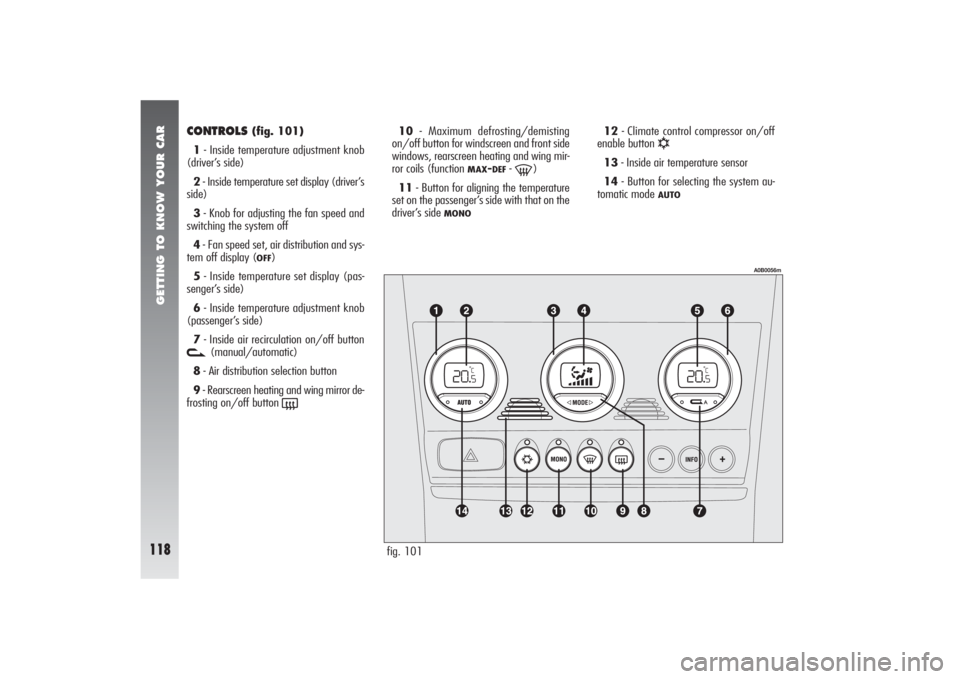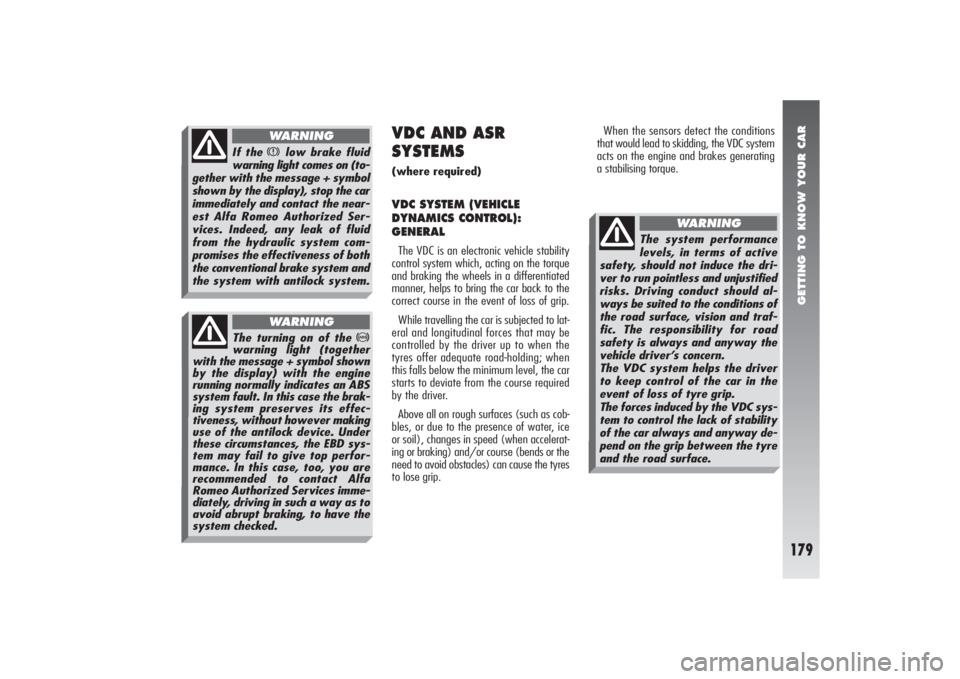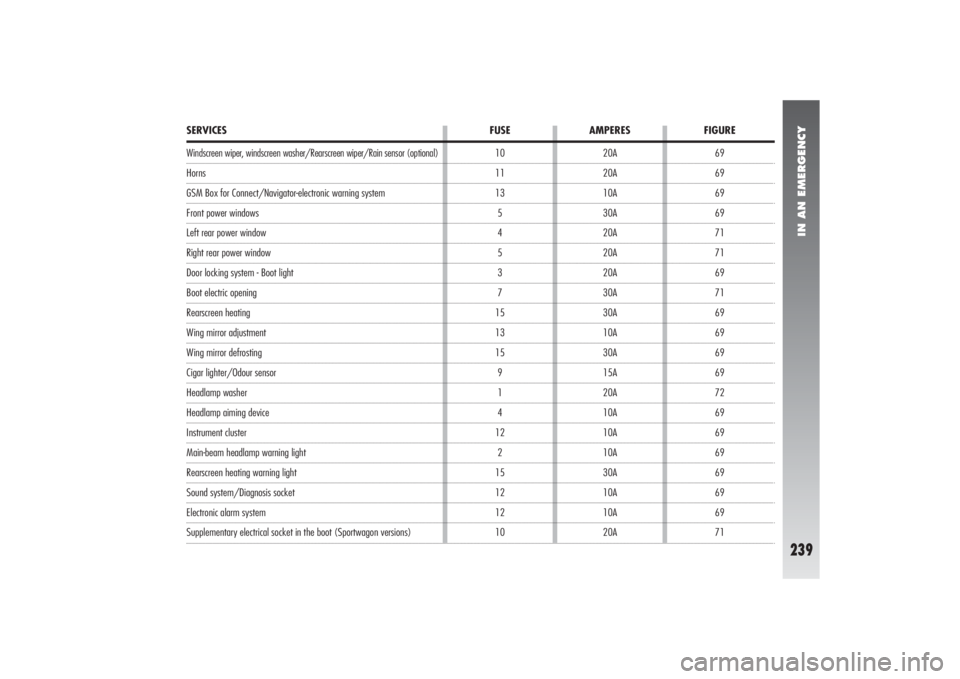sensor Alfa Romeo 156 2004 Owner handbook (in English)
[x] Cancel search | Manufacturer: ALFA ROMEO, Model Year: 2004, Model line: 156, Model: Alfa Romeo 156 2004Pages: 357, PDF Size: 5.04 MB
Page 118 of 357

GETTING TO KNOW YOUR CAR
116
The anti-pollution sensor
is placed in the air flow in
front of the combined par-
ticle activated carbon filter and,
therefore, must be protected
against possible compressed air
jets produced by cleaning equip-
ment. Moreover, the water col-
lected from the windscreen wipers
should not come into contact with
the sensor: otherwise, the internal
air recirculation function could be
disabled for long periods.
WARNINGThe demisting procedure is
enabled every time the ignition key is turned
to MAR, or pressing the
AUTO
button.
When this procedure is working it can be
turned off pressing one of the following but-
tons: compressor, air recirculation, air dis-
tribution, air flow. This operation inhibits the
incipient misting sensor signal until the AUTO
button is pressed again or the next time the
ignition key is turned to MAR.
On certain versions, the system is inte-
grated by an anti-pollution sensor that is able
to switch on the inside air recirculation func-
tion automatically, to reduce the unpleasant
smell of polluted air when driving in urban
areas, queues, tunnels, and when the wind-
screen wash/wiper is operated (with the
typical smell of spirits).WARNINGThe function of the anti-pol-
lution sensor is subordinate to safety con-
ditions; therefore disabling the climate con-
trol compressor or at an outside temperature
below 4°C, the sensor is disabled. In any
case, the sensor can be re-enabled press-
ing the recirculation button
v
until taking
it to the automatic mode. To ensure correct opera-
tion of the incipient misting
sensor, stickers (e.g. road
licence holder) must not be applied
in the “control” area between the
sensor and the windscreen. For this
very reason, both the sensor and
the windscreen must always be
kept clean, to avoid accumulation
of dirt or other substances.
Page 120 of 357

GETTING TO KNOW YOUR CAR
118
CONTROLS
(fig. 101)
1- Inside temperature adjustment knob
(driver’s side)
2- Inside temperature set display (driver’s
side)
3- Knob for adjusting the fan speed and
switching the system off
4- Fan speed set, air distribution and sys-
tem off display (OFF
)
5- Inside temperature set display (pas-
senger’s side)
6- Inside temperature adjustment knob
(passenger’s side)
7- Inside air recirculation on/off button
v
(manual/automatic)
8- Air distribution selection button
9- Rearscreen heating and wing mirror de-
frosting on/off button
(
10- Maximum defrosting/demisting
on/off button for windscreen and front side
windows, rearscreen heating and wing mir-
ror coils (function
MAX
-DEF
- -
)
11- Button for aligning the temperature
set on the passenger’s side with that on the
driver’s side
MONO
12- Climate control compressor on/off
enable button
√
13- Inside air temperature sensor
14- Button for selecting the system au-
tomatic mode
AUTO
fig. 101
A0B0056m
Page 131 of 357

GETTING TO KNOW YOUR CAR
129
fig. 111
A0B0072m
INSIDE AIR RECIRCULATION
ON/OFF BUTTON
v
(fig. 111)
Inside air recirculation is controlled ac-
cording to three operating logics:
– automatic control, indicated by the turn-
ing on of the right led on the button;
– forced switching on (inside air recircu-
lation always on), indicated by the turning
on of the left led on the button (and by the
right led going off at the same time);
– forced switching off (inside air recircu-
lation always off, with air inlet from the out-
side), indicated by the turning off of both
leds.
These operating conditions are obtained
by pressing in sequence the inside air recir-
culation button (7)
v
.
When inside air recirculation is controlled
automatically by the system, the right led
on the air recirculation button (7)
v
stays on all the time and the left led shows
the air recirculation condition:
ON= air recirculation operating;
OFF= air recirculation off.If inside air recirculation has been switched
on or off manually, the led on button (14)
AUTO
turns off.In automatic operation, inside air recircu-
lation is switched on automatically when the
anti-pollution sensor detects the presence of
polluted air, for instance in cities, queues,
tunnels, and when the windscreen
wash/wiper is operated (with the charac-
teristic smell of spirit).
Page 172 of 357

GETTING TO KNOW YOUR CAR
170
Lifting the boot lid is made easier by the
action of gas springs.
OPENING WITH REMOTE
CONTROL
(fig. 162)
The luggage compartment can be opened
by remote control from outside pressing the
button (C), also when the electronic alarm
is on (where applicable).
In this case, the alarm system switches off
volumetric protection and the boot lid con-
trol sensor. The system also sounds two
beeps and the arrows light up for about
three seconds (with the exception of ver-
sions for certain markets).
Closing the boot again the control functions
are restored, the system sounds two beeps
and the arrows light up for about three sec-
onds (with the exception of versions for cer-
tain markets). the gas springs are cali-
brated to guarantee correct
operation with loading
specified by the manufacturer. Ar-
bitrary additions to the boot lid
(spoiler, etc.) may affect its oper-
ation and safety.
OPENING FROM INSIDE (fig. 161)
To open the boot from inside the passen-
ger compartment, pull the lever (A), at the
side of the driver’s seat.fig. 161
A0B0042m
fig. 162
A0B0743m
Only use the boot opening
lever with the vehicle sta-
tionary.
WARNING
Page 180 of 357

GETTING TO KNOW YOUR CAR
178
Braking on corners always requires the ut-
most caution, even with the help of the ABS.
The most important piece of advice, how-
ever, is the following:Following these instructions you will be
in a condition to obtain peak braking per-
formance at all times.
WARNINGCars fitted with ABS must
only be fitted with wheel rims, tyres and
brake linings of the type and brand approved
by the Manufacturer.
The braking system is completed by the
electronic control braking distribution system
called EBD(Electronic Braking Force Dis-
tributor) which distributes the braking action
through the ABSsystem control unit and
sensors.
In the event of a system
fault, with lighting up of
the
>
warning light on the instru-
ment cluster (together with the
message + symbol shown by the
display), have the vehicle checked
immediately by Alfa Romeo Au-
thorized Services, driving slowly
to be able to regain full system
performance.
WARNING
When the ABS cuts in and
you feel the pedal pulse, do
not reduce the pressure, but keep
the brake pedal firmly pressed
with no fear; this way you will
stop in the shortest possible space,
compatibly with the conditions of
the road surface.
WARNING
The car is fitted with an
electronic brake distributor
(EBD). If the
>
and
x
warning
lights, where required, come on at
the same time (together with the
message + symbol shown by the
display) when the engine is run-
ning, there is an EBD system fault;
in this case, violent braking may
lock the rear wheels too early, with
the possibility of skidding. Drive
extremely carefully to the nearest
Alfa Romeo Authorized Services to
have the system checked over.
WARNING
In order to be able to exploit as far as pos-
sible the possibility of the antilock system
in the case of need, it is wise to follow a few
pieces of advice:
The ABS exploits the avail-
able grip in full, but it can-
not increase it; therefore, caution
is required on slippery surfaces,
without running unnecessary risks.
WARNING
If the ABS cuts in, it means
that the grip limit between
the tyres and the road surface has
been reached: it is necessary to
slow down and adapt driving to
the grip available.
WARNING
Page 181 of 357

GETTING TO KNOW YOUR CAR
179
If the
x
low brake fluid
warning light comes on (to-
gether with the message + symbol
shown by the display), stop the car
immediately and contact the near-
est Alfa Romeo Authorized Ser-
vices. Indeed, any leak of fluid
from the hydraulic system com-
promises the effectiveness of both
the conventional brake system and
the system with antilock system.
WARNING
The turning on of the
>
warning light (together
with the message + symbol shown
by the display) with the engine
running normally indicates an ABS
system fault. In this case the brak-
ing system preserves its effec-
tiveness, without however making
use of the antilock device. Under
these circumstances, the EBD sys-
tem may fail to give top perfor-
mance. In this case, too, you are
recommended to contact Alfa
Romeo Authorized Services imme-
diately, driving in such a way as to
avoid abrupt braking, to have the
system checked.
WARNING
VDC AND ASR
SYSTEMS(where required)VDC SYSTEM (VEHICLE
DYNAMICS CONTROL):
GENERALThe VDC is an electronic vehicle stability
control system which, acting on the torque
and braking the wheels in a differentiated
manner, helps to bring the car back to the
correct course in the event of loss of grip.
While travelling the car is subjected to lat-
eral and longitudinal forces that may be
controlled by the driver up to when the
tyres offer adequate road-holding; when
this falls below the minimum level, the car
starts to deviate from the course required
by the driver.
Above all on rough surfaces (such as cob-
bles, or due to the presence of water, ice
or soil), changes in speed (when accelerat-
ing or braking) and/or course (bends or the
need to avoid obstacles) can cause the tyres
to lose grip.When the sensors detect the conditions
that would lead to skidding, the VDC system
acts on the engine and brakes generating
a stabilising torque.
The system performance
levels, in terms of active
safety, should not induce the dri-
ver to run pointless and unjustified
risks. Driving conduct should al-
ways be suited to the conditions of
the road surface, vision and traf-
fic. The responsibility for road
safety is always and anyway the
vehicle driver’s concern.
The VDC system helps the driver
to keep control of the car in the
event of loss of tyre grip.
The forces induced by the VDC sys-
tem to control the lack of stability
of the car always and anyway de-
pend on the grip between the tyre
and the road surface.
WARNING
Page 182 of 357

GETTING TO KNOW YOUR CAR
180
The heart of the VDC system is the VDC
control unit which with the data supplied by
the sensors installed on the car, calculates
the centrifugal forces generated when the
car is cornering. The yawing sensor detects
the rotations of the car around its own ver-
tical axis. The centrifugal forces generated
when the car is cornering are detected by
a highly sensitive lateral acceleration sensor.
The stabilising action of the VDC system is
based on calculations made by the
system’s electronic control unit which
processes the signals received from the
steering wheel rotation, lateral acceleration
and individual wheel rotation sensors. These
signals allow the control unit to recognise
the manoeuvre the driver intends to do
when turning the steering wheel.
The control unit processes the information
received from the sensors and is therefore
capable of detecting the position of the car
and comparing it with the trajectory the dri-
ver would like to follow instant by instant.
In the event of a discrepancy, the control
unit chooses and commands the most suit-
able action to bring the car back to the re-
quired course within a fraction of a second:
braking one or more wheels at a different
braking force and, if necessary it reduces the
power transmitted by the engine. The corrective actions are changed and con-
trolled continuously until the car returns to
the required course.
The action of the VDC system considerably
increases the active safety of the vehicle un-
der many critical situations and it is partic-
ularly useful also when the road surface grip
conditions change.
For the VDC, ASR and ABS
systems to work correctly,
the tyres must be of the same
brand and type on all wheels, in
perfect conditions and above all of
the specified type, brand and size.
WARNING
During use of the compact
spare wheel, the VDC sys-
tem continues working. It should be
borne in mind that the spare wheel
is smaller than a normal tyre,
therefore its grip is lower than that
of the other tyres of the car.
WARNING
VDC SYSTEM OPERATIONThe VDC system turns on automatically
when the car is started and cannot be
switched off. It is however possible to cut
off operation of the ASR system pressing the
corresponding button on the centre console.
The main components of the VDC system
are:
– an electronic control unit which
processes the signals received from the var-
ious sensors and brings about the most ap-
propriate strategy;
– a sensor that detects the position of the
steering wheel;
– four sensors that detect the rotation
speed of each wheel;
– a sensor that detects rotation of the car
around the vertical axis;
– a sensor that detects lateral acceleration
(centrifugal force).
Page 189 of 357

GETTING TO KNOW YOUR CAR
187
ENVIRONMENTAL
PROTECTIONThe design and construction of the vehi-
cle have not only been developed with the
traditional aspects of performance and
safety in mind, but also take into account
the increasingly pressing problems tied to
protecting the environment.
The choice of materials, techniques and
particular parts are the result of work which
has made it possible to drastically reduce
the harmful effects on the environment and
guarantee respect for the severest interna-
tional norms.USE OF NON-TOXIC
MATERIALSNone of the components of the vehicle con-
tains asbestos. The padding and the climate
control system do not contain CFCs which
are held to be responsible for the depletion
of the ozone layer.
The colouring agents and the corrosion in-
hibitors used on the nuts, screws and bolts
do not contain cadmium any more, which
could pollute the atmosphere or water tables.
PARKING SENSORS
(WHERE PROVIDED)(optional for versions/markets
where applicable)
The parking system detects and informs
the driver (through an intermittent acoustic
signal) about the presence of obstacles in
the rear part of the car (fig. 179). ACTIVATIONThe sensors are automatically activated
when the reverse gear is engaged.
The sound produced by the acoustic alarm
becomes continuous when the distance be-
tween the car and the obstacle is less that
30 cm.
ACOUSTIC SIGNALWhen the reverse gear is engaged an in-
termittent acoustic signal is automatically
activated.
The acoustic signal:
– raises with the reduction of distance be-
tween the car and the obstacle;
– becomes continuous when the distance
between the car and the obstacle is less that
30 cm and stops if the distance raises.
– is constant if the distance is unvaried.
If this situation takes place for side sensors,
the signal is stopped after about 3 seconds
to prevent sound indications when per-
forming manoeuvres near walls.fig. 179
A0B0609m
Page 190 of 357

GETTING TO KNOW YOUR CAR
188
EMISSION REDUCING DEVICES
(petrol engines)Trivalent catalytic converter
(catalytic silencer)
The exhaust system is fitted with a cat-
alyzer formed of alloys of noble metals. It
is housed in a stainless steel container which
is able to resist the high operating temper-
atures.
The catalyzer converts the unburnt hydro-
carbons, carbon monoxide and nitrogen ox-
ides present in the exhaust gas (even if in
small quantities thanks to the electronic in-
jection and ignition system) into harmless
compounds.Lambda probe
A sensor (lambda probe) measures the
content of oxygen present in the exhaust
gas. The signal transmitted by the lambda
probe is use by the injection and ignition
electronic control unit to adjust the air-fuel
mixture.
Anti-evaporation system
As it is impossible, even when the engine
is switched off, to prevent the formation of
fuel vapours, a system has been devised
which imprisons the vapours in a special ac-
tivated carbon container.
During operation of the engine, these
vapours are sucked up and sent to com-
bustion.
EMISSION REDUCING DEVICES
(JTD engines )Oxidising catalytic converter
Converts the polluting substances present
in the exhaust gases (carbon monoxide, un-
burned hydrocarbons and particulate) into
harmless substances, thus reducing the
fumes and smell that are typical of diesel
engines.
The catalytic converter consists of a stain-
less steel case that houses a ceramic hon-
eycomb body coated with noble metal used
as a catalyst.
Exhaust gas recirculation system
(E.G.R.)
This system recycles, i.e. re-uses, a vary-
ing percentage of the exhaust gases, de-
pending on engine operating conditions.
It is used, when necessary, to control ni-
tric oxides.
Due to the high tempera-
tures reached during oper-
ation of the catalytic converter, the
vehicle should not be parked over
inflammable materials (paper, fuel
oils, grass, dry leaves, etc.).
WARNING
Page 241 of 357

IN AN EMERGENCY
239
69
69
69
69
71
71
69
71
69
69
69
69
72
69
69
69
69
69
69
71 10
11
13
5
4
5
3
7
15
13
15
9
1
4
12
2
15
12
12
10
SERVICES FUSE AMPERES FIGUREWindscreen wiper, windscreen washer/Rearscreen wiper/Rain sensor (optional)HornsGSM Box for Connect/Navigator-electronic warning systemFront power windowsLeft rear power windowRight rear power windowDoor locking system - Boot lightBoot electric openingRearscreen heatingWing mirror adjustmentWing mirror defrostingCigar lighter/Odour sensorHeadlamp washerHeadlamp aiming deviceInstrument clusterMain-beam headlamp warning lightRearscreen heating warning lightSound system/Diagnosis socketElectronic alarm system Supplementary electrical socket in the boot (Sportwagon versions)20A
20A
10A
30A
20A
20A
20A
30A
30A
10A
30A
15A
20A
10A
10A
10A
30A
10A
10A
20A